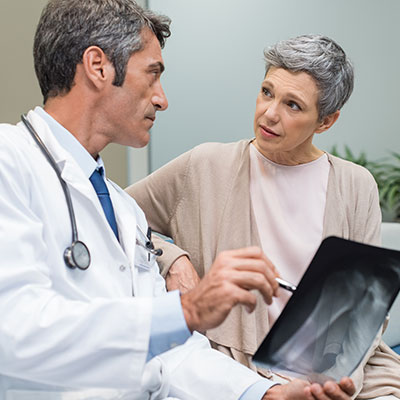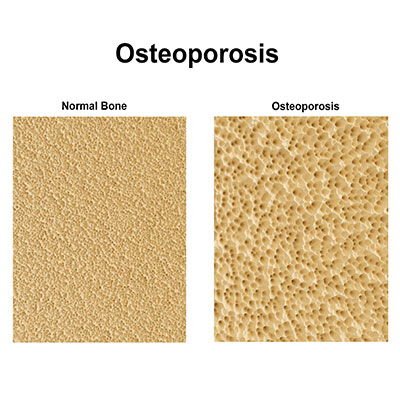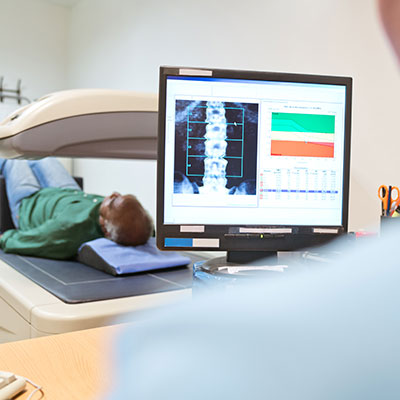HGH Therapy Benefits for Better Fracture Healing

As we get older, we struggle with numerous health issues, a major one being the increased risk of osteoporosis. The greatest risk to people with osteoporosis is bone fractures. If it seems as though bone fractures take longer to heal in older men and women, it is because they do.
Each day, some of your bone cells go through a remodeling phase, where old cells die off and get resorbed into the body. New cells are necessary to take their place. As we age, this process slows, leading to a decrease in bone density. This weakening of the bones is why the elderly are at a far greater risk of developing osteoporosis and are more susceptible to fractures.
Fractures are common in people with osteoporosis because it usually occurs around the same time that people start to experience balance, weakness, and other issues that can cause falls. Fractures are also harder to heal in older people, making osteoporosis fractures particularly dangerous.
HGH is largely responsible for the regeneration of every cell in the body, including bone and muscle. As you age, your pituitary gland decreases HGH secretion. The result is fewer new cells to maintain the body’s muscles and bones. This leads to reduced bone density, meaning bones become weaker and more brittle. Reduced bone density left untreated can result in osteoporosis.
How Does HGH Benefit Bone Density?
HGH can help to prevent and heal fractures by strengthening bone and increasing bone density. As a child grows into an adult, it is HGH that is primarily responsible for the bone growth that results in longer bones, which makes us grow taller. That process of bones growing longer and stronger is known as “bone remodeling.”
It is the process of new bone formation by osteoblasts (cells that form new bone) and bone resorption by osteoclasts. HGH directly and through IGF-I stimulates osteoblast proliferation and activity, promoting bone formation. It also stimulates osteoclast differentiation and activity, promoting bone resorption. The result is an increase in the overall rate of bone remodeling, with a net effect of bone accumulation and increased bone density.
As HGH levels drop in elderly adults, it results in a reduced rate of bone remodeling and a gradual loss of bone mineral density.
Can HGH Speed Bone and Joint Healing?
You are probably familiar with collagen as it relates to healthy skin. HGH stimulates collagen production. This is why one of the many benefits of growth hormone replacement therapy is healthier, younger-looking skin. But collagen does more than plump, thicken, and tighten the skin; it also cushions the joints. That is why HGH also helps to heal joints.
As far as bones go, HGH improves fracture healing and speeds bone recovery by infusing osteoblasts (new bone cells) into the damaged area. First comes the blood clot, which brings the inflammatory clean-up cells to the fracture. Then the osteoblasts begin to fill in the gap. Chondroblasts provide new cartilage. HGH goes to work stimulating the production of all these different cells to create new bone in place of the fracture.
At the same time as it is increasing your bone density, HGH also improves lean muscle mass. It is the body’s muscles that support and protect the bones from damage. Helping to build and strengthen muscle is another way that HGH works to prevent fractures in older men and women.
What Is Osteoporosis?

Can HGH Be Used to Treat Osteoporosis and Reduce the Risk of Fractures?
HGH has been shown to help prevent osteoporosis fractures in a number of ways. First and foremost, HGH can improve bone density and make up for the bone loss typical of patients with osteoporosis. HGH also can help patients lose weight, which puts less pressure on bones. HGH therapy also helps to build muscle and ligaments, which support bones, improve balance, and strengthens the overall musculoskeletal system.
As we get older, we struggle with numerous health issues, a major one being the increased risk of osteoporosis. The greatest risk to people with osteoporosis is bone fractures. Fractures are common in people with osteoporosis because it usually occurs around the same time that people start to experience balance, weakness, and other issues that can cause falls. Fractures are also harder to heal in older people, making osteoporosis fractures particularly dangerous.
A landmark study published in 2015 in the Endocrine Society’s Journal of Clinical Endocrinology & Metabolism found that for many years after it was given, HGH continued to reduce the risk of fractures and helped maintain bone density in postmenopausal women who had osteoporosis.
Since then, a recent literature review and meta-analysis indicated that growth hormone replacement therapy reduces the risk of fracture in all patients with osteoporosis, men and women. The researchers concluded that HGH can enhance bone mass and can protect against osteoporosis fractures “quite efficiently.”
They also particularly recommended HGH therapy for women over the age of 40 and for postmenopausal women. These women are part of the biggest risk group to develop osteoporosis and suffer from common fractures.
What Does the Medical Research Say About HGH and Bone Health?

A recent study published in the Journal of Clinical Endocrinology & Metabolism proved that the HGH helps to reduce the risk of fractures and maintain the bone mass within healthy levels among postmenopausal women who have been diagnosed with osteoporosis. Furthermore, that study indicated the results of HGH treatment for osteoporosis were long-lasting, concluding, “A decade after the study began, the women who received the larger growth hormone dose still had higher bone mineral density levels than the participants who received the lower dose or the placebo.”
A 2018 study concluded, “Patients who received HGH had a significant decrease in fracture risk as compared to control.”
Earlier studies said that “Treatment of osteoporosis with HGH is found to be beneficial due to the increased bone metabolism and improved bone geometry which occurs with HGH.” Another study in that same year in 1998 concluded that “GH treatment for more than 18 months gives increased bone formation and bone mineralization of newly produced bone and a concomitant increase in bone mass as determined with DEXA. Thus, the action of GH on bone metabolism in GHD adults is 2-fold: it stimulates both bone resorption and bone formation.”
Now that you know a little bit more about the link between HGH, osteoporosis, and bone fractures, why not take a minute to contact us and learn more about how growth hormone replacement therapy can improve your quality of life?
FAQ
What Are the Signs And Symptoms Of Osteoporosis?
There typically are no symptoms in the early stages of bone loss. But once your bones have been weakened by osteoporosis, you might have signs and symptoms that include:
- Back pain, caused by a fractured or collapsed vertebra
- Loss of height over time
- A stooped posture
- A bone that breaks much more easily than expected
What Is the Main Cause Of Osteoporosis?
Your bones are in a constant state of renewal — new bone is made, and old bone is broken down. HGH is a prime mover in this process. As we age, HGH levels drop, and old is no longer replaced as well as it was when we were younger, and bone mass is lost faster than it's created.
This leads to the weakening of bones typical of osteoporosis. Osteoporosis affects men and women of all races. But white and Asian women — especially older women who are past menopause — are at the highest risk of developing osteoporosis.
How Can HGH Be Used to Treat Osteoporosis?
Many scientific studies have found that even for years after it has been administered, HGH continued to reduce the risk of fractures and helped maintain bone density, particularly in postmenopausal women who had osteoporosis.
Other Than HGH, Are There Other Hormones that Can Help Heal or Prevent Bone Fractures?
Both human growth hormone (HGH) and testosterone play a vital role in bone health. Of the two, HGH is more important as it is instrumental to both bone and muscle growth. Since it is muscles that provide support for skeletal bones, muscle and bone are intricately related. Stronger muscles mean stronger bones and a lowered risk of osteoporosis-related fractures.
How Is Osteoporosis Diagnosed?
Osteoporosis is diagnosed by determining your bone density. Your bone density can be measured by a machine that uses low levels of X-rays to determine the proportion of minerals in your bones. During this painless test, you lie on a padded table as a scanner passes over your body. In most cases, only a few bones are checked — usually in the hip and spine.
Can Osteoporosis be Prevented?
Good nutrition and regular exercise are essential for keeping your bones healthy throughout your life. A healthy diet and weight-bearing exercise can help prevent bone loss or strengthen already weak bones. Specifically, adding more protein and calcium to your diet can help to strengthen bones.
Exercise can help you strengthen muscle and bone, but it can also help you lose weight, thus putting less stress on your bones. Certain supplements like vitamin D have also been shown to improve your body's ability to absorb calcium and improve bone health in other ways.


